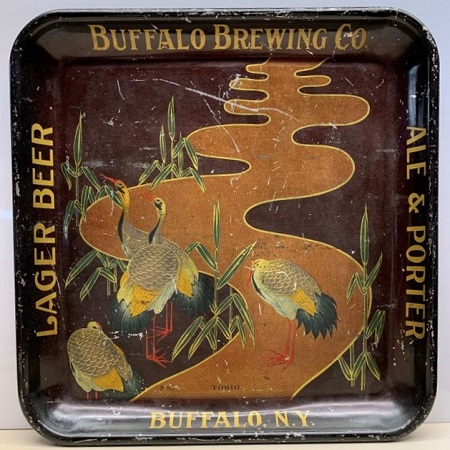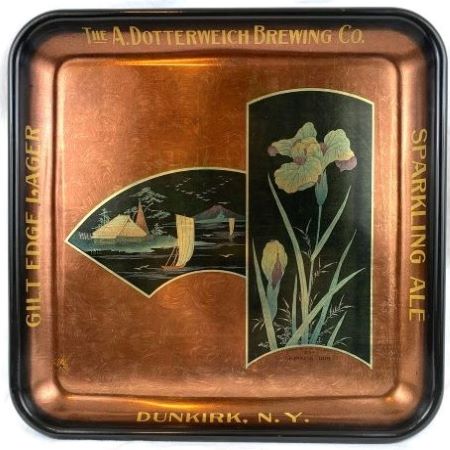The 'Stock' Exchange
American Art Works: 108 "Tokio"
American Art Works: 108 "Tokio"
Date: 1910 to 1912
Size: 13.5" x 13.5"
Type: Pie
Scarcity: Rare
Value: $$ to $$$$
Condition & Brewer Dependent
Size: 13.5" x 13.5"
Type: Pie
Scarcity: Rare
Value: $$ to $$$$
Condition & Brewer Dependent


108 "Tokio"
94 "Japanese Iris"
General
Although there are a few more Asian-inspired designs coming in the catalog, “Tokio” represents the last of the “japaned” designs. No. 108 deviates from the typical “japaned” designed in that the primary background color is not black, but a dark maroon. There is some precedence for this in actual “japaned” lacquerware trays, although they tend more toward red than maroon. This design also features more colors than the typical “japaned” design, although again there are some examples among actual lacquerware.
It is unclear if the title refers to the Japanese city we know as Tokyo; apparently Tokio was a well-accepted spelling around the time this design was created and is based on some oddities of transliteration between Japanese kanji characters and English that were not yet standardized at the time. Although originally established in the 12th century, or possibly earlier, as Edo, it became Tokyo (meaning “eastern capital”) following Emperor Meiji’s relocation there in 1889.
The oriental white stork was fairly widespread throughout Asia and common at the time this design was created, although they have since become endangered. In many East Asian countries, the stork is believed to represent prosperity and longevity. It was believed during the earlier times that the stork can live up to an old age. It is also a symbol of grace, wisdom, and luck. Interestingly, the storks as depicted in this design, appear to be based on the European stork; they are recognizable by the red beak versus the black beak of the Asian variety. River symbolism general indicates the power of nature and fertility, although it can also refer to the passage of time.
It is unclear whom this design was targeted at; unfortunately, Meek/American Art Works appears to have abandoned printed catalogs. Some other designs from this time frame have small paper labels attached with descriptions similar to what appeared in the old catalogs that give some hint; unfortunately, we’ve never seen one for this design. It is possible that it was meant as a “tea tray” to capitalize on the convergence of an interest in Japanese culture at the time and the repopularization of tea as a beverage.
Since the Revolution, Americans had something of an aversion to tea (a British beverage), but that began to change with New York tea importer Thomas Sullivan’s inadvertent invention of tea bags in 1908. It occurred when he sent tea samples to clients in small silk bags to cut costs, and they mistakenly steeped the bags whole. The customers were more interested in the brewing convenience of the novel silk bags than his bulk teas. Sullivan did not realize this until they all started to complain that the orders, they received were not in the same small bags the samples had been in. Silk was too expensive for everyday disposal; therefore, he invented tea bags made of gauze.
Sahling has no entry in his workbook for this design.
Size & Shape and Advertising Placement
The few examples we have encountered have all been square trays, no other sizes or sign examples. The rims are unusual and similar to No. 94 (Japanese Irises) in that the maroon of the main tray carries up the side of the rim with only the top edge being black. Advertising text only appears on the rim in gold.
Hager & Price
Hager does not discuss this design or include it in his date table and he does not include it in his catalog. We speculate that is because he never encountered an example. Together we’ve only seen a total of four Tokio trays, all by breweries. Prices are somewhat better than average compared to other designs, but not as much as one would expect given its rarity. The best (condition) example, for A Dotterweich of Dunkirk, NY went for $1,200.
Although there are a few more Asian-inspired designs coming in the catalog, “Tokio” represents the last of the “japaned” designs. No. 108 deviates from the typical “japaned” designed in that the primary background color is not black, but a dark maroon. There is some precedence for this in actual “japaned” lacquerware trays, although they tend more toward red than maroon. This design also features more colors than the typical “japaned” design, although again there are some examples among actual lacquerware.
It is unclear if the title refers to the Japanese city we know as Tokyo; apparently Tokio was a well-accepted spelling around the time this design was created and is based on some oddities of transliteration between Japanese kanji characters and English that were not yet standardized at the time. Although originally established in the 12th century, or possibly earlier, as Edo, it became Tokyo (meaning “eastern capital”) following Emperor Meiji’s relocation there in 1889.
The oriental white stork was fairly widespread throughout Asia and common at the time this design was created, although they have since become endangered. In many East Asian countries, the stork is believed to represent prosperity and longevity. It was believed during the earlier times that the stork can live up to an old age. It is also a symbol of grace, wisdom, and luck. Interestingly, the storks as depicted in this design, appear to be based on the European stork; they are recognizable by the red beak versus the black beak of the Asian variety. River symbolism general indicates the power of nature and fertility, although it can also refer to the passage of time.
It is unclear whom this design was targeted at; unfortunately, Meek/American Art Works appears to have abandoned printed catalogs. Some other designs from this time frame have small paper labels attached with descriptions similar to what appeared in the old catalogs that give some hint; unfortunately, we’ve never seen one for this design. It is possible that it was meant as a “tea tray” to capitalize on the convergence of an interest in Japanese culture at the time and the repopularization of tea as a beverage.
Since the Revolution, Americans had something of an aversion to tea (a British beverage), but that began to change with New York tea importer Thomas Sullivan’s inadvertent invention of tea bags in 1908. It occurred when he sent tea samples to clients in small silk bags to cut costs, and they mistakenly steeped the bags whole. The customers were more interested in the brewing convenience of the novel silk bags than his bulk teas. Sullivan did not realize this until they all started to complain that the orders, they received were not in the same small bags the samples had been in. Silk was too expensive for everyday disposal; therefore, he invented tea bags made of gauze.
Sahling has no entry in his workbook for this design.
Size & Shape and Advertising Placement
The few examples we have encountered have all been square trays, no other sizes or sign examples. The rims are unusual and similar to No. 94 (Japanese Irises) in that the maroon of the main tray carries up the side of the rim with only the top edge being black. Advertising text only appears on the rim in gold.
Hager & Price
Hager does not discuss this design or include it in his date table and he does not include it in his catalog. We speculate that is because he never encountered an example. Together we’ve only seen a total of four Tokio trays, all by breweries. Prices are somewhat better than average compared to other designs, but not as much as one would expect given its rarity. The best (condition) example, for A Dotterweich of Dunkirk, NY went for $1,200.
Confirmed Brewer used Stock Trays
Non-Beer Related & Non-Tray Uses
Click the Picture to Return to Meek & Beach Stock Catalog Page



















